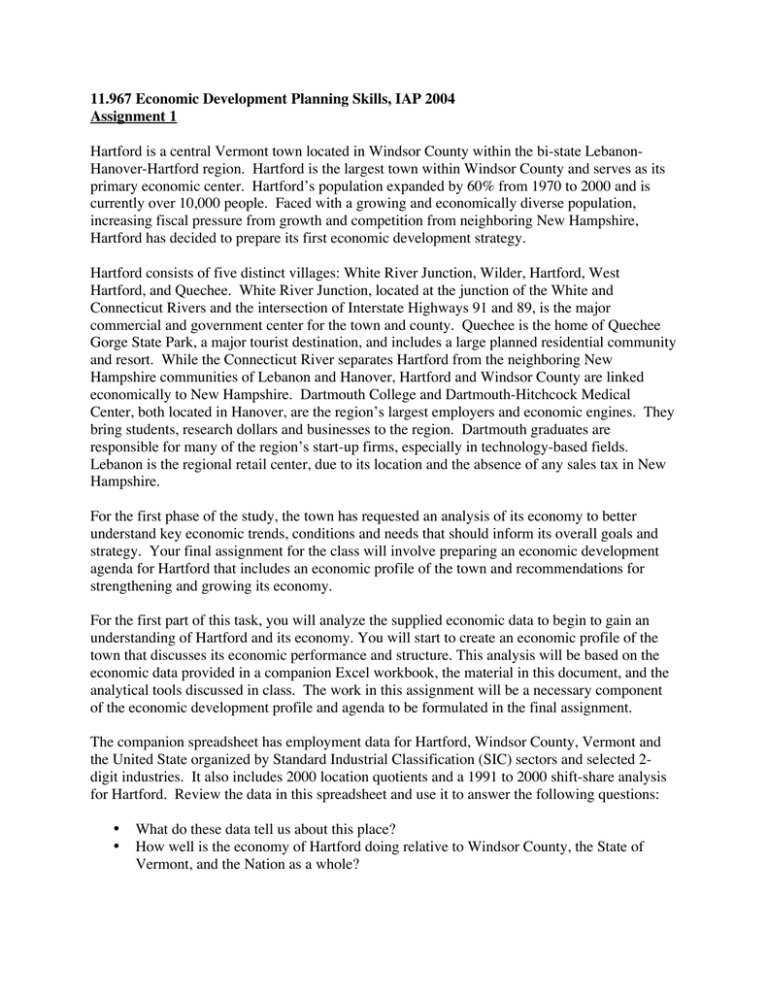11.967 Economic Development Planning Skills, IAP 2004 Assignment 1
advertisement

11.967 Economic Development Planning Skills, IAP 2004 Assignment 1 Hartford is a central Vermont town located in Windsor County within the bi-state LebanonHanover-Hartford region. Hartford is the largest town within Windsor County and serves as its primary economic center. Hartford’s population expanded by 60% from 1970 to 2000 and is currently over 10,000 people. Faced with a growing and economically diverse population, increasing fiscal pressure from growth and competition from neighboring New Hampshire, Hartford has decided to prepare its first economic development strategy. Hartford consists of five distinct villages: White River Junction, Wilder, Hartford, West Hartford, and Quechee. White River Junction, located at the junction of the White and Connecticut Rivers and the intersection of Interstate Highways 91 and 89, is the major commercial and government center for the town and county. Quechee is the home of Quechee Gorge State Park, a major tourist destination, and includes a large planned residential community and resort. While the Connecticut River separates Hartford from the neighboring New Hampshire communities of Lebanon and Hanover, Hartford and Windsor County are linked economically to New Hampshire. Dartmouth College and Dartmouth-Hitchcock Medical Center, both located in Hanover, are the region’s largest employers and economic engines. They bring students, research dollars and businesses to the region. Dartmouth graduates are responsible for many of the region’s start-up firms, especially in technology-based fields. Lebanon is the regional retail center, due to its location and the absence of any sales tax in New Hampshire. For the first phase of the study, the town has requested an analysis of its economy to better understand key economic trends, conditions and needs that should inform its overall goals and strategy. Your final assignment for the class will involve preparing an economic development agenda for Hartford that includes an economic profile of the town and recommendations for strengthening and growing its economy. For the first part of this task, you will analyze the supplied economic data to begin to gain an understanding of Hartford and its economy. You will start to create an economic profile of the town that discusses its economic performance and structure. This analysis will be based on the economic data provided in a companion Excel workbook, the material in this document, and the analytical tools discussed in class. The work in this assignment will be a necessary component of the economic development profile and agenda to be formulated in the final assignment. The companion spreadsheet has employment data for Hartford, Windsor County, Vermont and the United State organized by Standard Industrial Classification (SIC) sectors and selected 2 digit industries. It also includes 2000 location quotients and a 1991 to 2000 shift-share analysis for Hartford. Review the data in this spreadsheet and use it to answer the following questions: • What do these data tell us about this place? • How well is the economy of Hartford doing relative to Windsor County, the State of Vermont, and the Nation as a whole? • What is unique about the Hartford economy? How does its structure differ from Windsor County and the State of Vermont? • What are the most important sectors of the Hartford economy? Which are growing fastest? • How does growth in Hartford’s sectors and industries compare to Windsor County and the State of Vermont? • Can we define industry clusters in the economy? Are there some clusters that are more important than others? • What do these data not tell us about Hartford? What additional information and analysis do you need to gain a better understanding of the town’s economy? You may want to prepare graphs to summarize some of this data to aid in your analysis and use in your final profile document.




